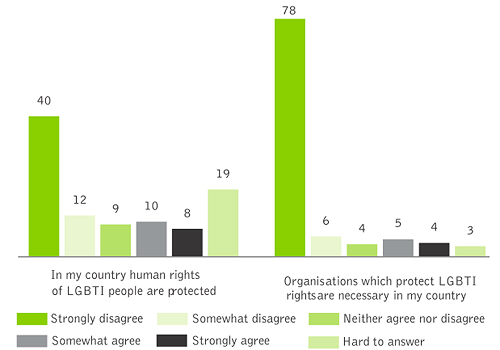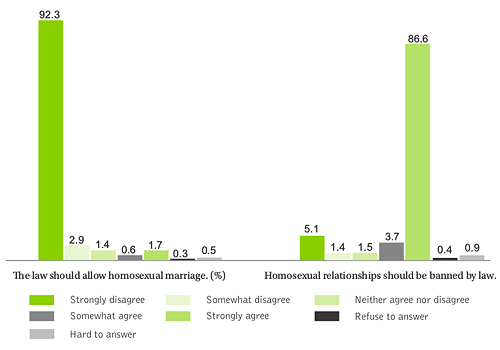In recent years, the number of violent attacks against the LGBT community in Armenia increased. In 2012 the DIY pub in Yerevan was the target of an arson attack because it was known to be a gay friendly space, and earlier this year five LGBTI activists were attacked in Yerevan. These are just two examples of acts of physical violence against representatives of the country's LGBTI community. However, while these two acts are well known, there is still very little data on violence towards Armenia's LGBTI community. Very few organizations and people are taking it upon themselves to research violence against the LGBTI community in Armenia, or the systematic disadvantage its members might experience here.
Currently, the majority of information about the LGBTI community has been supplied by PINK Armenia, (Public Information and Need for Knowledge), a Yerevan-based non-profit which focuses on LGBTI rights in Armenia. Recently, PINK published a report entitled “From Prejudice to Equality, Study of Social Attitudes towards LGBTI people in Armenia.” This report focuses on homophobia towards the Armenian LGBTI community, as well as the public's perceptions of LGBTI individuals.
While the report was limited by several factors, such as willing respondents and respondents who understand varying sexual and gender identities, it does shed light on how people in Armenia see and currently feel about the LGBTI community within the country. Because of the rarity of such a report, Epress.am has decided to publish a summary of it in order to start a conversation about homophobia in Armenia.
Information About the Survey
In order to prepare this report, PINK conducted a one-of-a-kind survey that would be randomly distributed to the public. This survey is unique in its size: due to the large number of respondents, it is the first survey conducted in Armenia about the LGBTI community, which has a large enough sample size to properly reflect perceptions of the rest of the Armenian population.
The surveyors randomly selected people from a list provided to them by the CJSC “Electric Networks of Armenia.”All of the people that participated – a total number of 1,017 respondents – were between the ages of 18 and 65. However, 30% of the respondents refused to participate in the survey.
One of the reasons for this was what is referred to as “closed doors.” In most surveys, closed doors are a common problem. As stated in the report, “[Closed doors] are cases when the interviewer is assigned a randomly selected sample house that happens to be no longer inhabited.” However, this was a larger problem in this survey because of the large number of Armenians who are currently emigrating for work abroad. Often, when the fieldworkers approached the homes that they were randomly assigned, they found them uninhabited.
Another problem that the fieldworkers identified was that many of respondents refused to participate in the survey because of its content.
Due to the nature of the survey, many of the interviewers wanted to interview the respondents in private. However, in many cases, the family members of the respondents were present during the interview. The report stated that in these cases, “the respondent felt stressed and answered the questions in an elusive manner. This was especially the case with young women and girls who were apprehensive of the reaction of their husbands or other family members; they gave rushed answers or avoided direct responses.”
In other cases, the respondents became agitated because of the content of the survey and forced the interviewers away from their homes.
Because of these negative reactions, the report states that, “the interviewers believe that it is too early to conduct a survey using a questionnaire with detailed questions for various LGBTI groups.”
The report stated that the majority of the interviewees did not know the difference between the various LGBTI identities, and that most of the people they interviewed divided members of Armenian’s LGBTI community into two separate categories: cisgender female and male homosexuals.
Because of this, many of the questions of the survey focused on cisgender homosexual men and women, not bisexual, transgender people, or other queer people with varying identities.
Visibility of the LGBTI Community in Armenia
Page 40 chart 7: Do you know any person who is LGBTI? If yes, indicate the information about his/her/their sexual orientation or gender identity.
Most of the questions in the survey asked the respondents if they agreed with common stereotypes about LGBTI people. The report argues that one of the reasons of common stereotypes about LGBTI people in Armenia is the lack of communication people have with members of these communities in Armenia. If a person knows information about the LGBTI community in Armenia, it is usually obtained by third party sources like the media, and not from actual members of the community. Furthermore, the report found that while people might actually know an LGBTI person, they commonly refrained from acknowledging that they knew such a person or had a contact with them in order not to be stigmatized.
“The intensity of interaction reduces the space for stereotypes and prejudice, giving way to experience-based knowledge. It is also logical that the respondents’ attitudes are mostly stereotypical, because only 9% of all respondents mentioned having encounters with LGBTI persons, or more precisely with one or two of these groups,” the report stated.
It added that out of over one thousand (1,017) respondents, only 9% mentioned that they knew or were familiar with LGBTI persons. “However, it is noteworthy that they are familiar with only one (41%) or two (26%) such persons.” Furthermore, the majority of the people who know an LGBTI person know a homosexual man (73%), and a far fewer number know a homosexual woman (22%).
The following are the results of the survey that was given to people in Armenia: “In order to identify stereotypes about homosexual men and women, the respondents were asked to express their agreement or disagreement with a number of statements, which were based on the most popular and widespread stereotypes about homosexual people.”
It is important to note that 10-40% of the respondents found it difficult to answer at least one of the questions, and that many of the respondents felt more strangely about stereotypes about cisgender homosexual men than women.
The following are excerpts from the report published by PINK:
Page 37 – Chart 4: Please note which thesis you agree with the most
Stereotypes About Gay Men in Armenia
“Gay men are characterized as being feminine (58%).”
“Paying greater attention to their appearance and fashion (66%).”
“As emotional, artistic and creative (42%).”
“Fifty-six percent of the respondents agreed with this statement [That gay men are one of the principal transmitters of HIV].”
“Another widespread myth is that gay men are child molesters. Sixty percent of respondents agreed with this statement.”
Stereotypes About Lesbians in Armenia
“The most widespread myth that also scored highest in the responses was that Lesbians hate men (48%).”
“Twenty-nine percent of the respondents found it difficult to express any opinion on this statement.”
“Only 19% of the respondents agree that lesbian women do not pay attention their appearance. Moreover, just 3% believe that all women who do not care for their appearance are lesbian. If, in the case of the former statement, 31% of the respondents found it difficult to answer the question, for the later statement, the responses are straightforward: the predominant majority (85%) of the survey participants disagree that all women who do not pay attention to their appearance are lesbian.”
“Twenty-six percent of the respondents characterize lesbian women as radical feminists, while 40% refrained from making any judgment on this. One-third of the respondents believe that homosexual women are more aggressive (33%), and at the same time, that they are stronger and more independent (31%) than heterosexual women.”
Views on Homosexuality in General
“The overwhelming majority of the respondents (84%) are assured that homosexuality has a tendency to spread, and if the public is not alert and does not take measures to contain it by “propagating” heterosexuality, it is likely that the number of homosexual people will increase.”
“Sixty-six percent of respondents agree that it is under the influence of ‘Western values’ that people change their sexual orientation in Armenia.”
“The statement that homosexuality is a product of improper up brining has already been discussed above. One-third of the respondents agree with this statement. Similarly, exactly half of the respondents think that a child growing up in a homosexual family will also become homosexual.”
“A significant number of respondents also believe that homosexuality is rejected at all times and everywhere. Eighty-four percent of the respondents dismiss the idea that there is or has been a tolerant attitude toward homosexual people of any setting.”
“Nonetheless, the statement about homosexuality being a phenomenon that is encountered in nature divided the respondents. Firstly, 38% of the respondents found it difficult to expressed any opinion, while 13% expressed a neutral position, which, according to the interviewers, can be interpreted as ‘Difficult to answer.’ In sum, almost half of the respondents avoided giving a clear positon on this question. The rest of the respondents are divided into those who reject the existence of homosexuality in the animal world (23%) and those who agree that it does exist (25%).”
“The myth that the EU is an agent of propagating and spreading ‘Western Values’ is also prevalent. The respondents frequently label homosexuality as a Western Value, and consequently, a negative attitude is formed not only towards homosexuality, but also towards the European Union. Ninety-four percent of respondents did not agree with the statement, ‘In order to join the European Union, Armenia must legalize same-sex marriage'.”
Perceptions of the Rights of LGBTI Persons
The field workers also asked the respondents questions about the rights of LGBTI people in Armenia, When asked if the respondents thought that the rights LGBTI people in Armenia were not protected, fifty-two percent agreed with that statement. And when asked if they agreed that there should be organizations protecting the rights of LGBTI people in Armenia, only 7% of respondents agreed with that statement.
Page 46 chart 10
The fieldworkers also asked the respondents if they thought that homosexuality should be outlawed. 90% of respondents agreed with that statement, and only 2% stated that they would agree with a law allowing homosexual marriage.
Page 46 chart 11
Furthermore, the survey also found that “nine out of ten respondents believe that homosexual women and men should not be allowed to work with children, and homosexual persons should not have the right to adopt children.”
Article prepared by Katherine Berjikian.
 Epress.am News from Armenia
Epress.am News from Armenia



